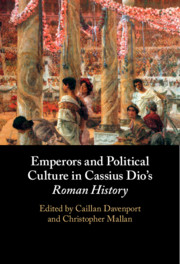Book contents
- Emperors and Political Culture in Cassius Dio’s Roman History
- Emperors and Political Culture in Cassius Dio’s Roman History
- Copyright page
- Contents
- Figures
- Contributors
- Preface
- Abbreviations
- Introduction Cassius Dio
- I Imperial and Political Narratives
- II Emperors and Biographies
- Chapter 5 Cassius Dio’s Funeral Speech for Augustus
- Chapter 6 ‘ … But He Possessed a Most Singular Nature’
- Chapter 7 An Emperor’s War on Greece
- Chapter 8 War and Peace
- III Political Groups and Political Culture
- IV Reception and Reflection
- Bibliography
- Index
Chapter 8 - War and Peace
Imperial Leadership in Dio’s Second-Century Narrative
from II - Emperors and Biographies
Published online by Cambridge University Press: 23 July 2021
- Emperors and Political Culture in Cassius Dio’s Roman History
- Emperors and Political Culture in Cassius Dio’s Roman History
- Copyright page
- Contents
- Figures
- Contributors
- Preface
- Abbreviations
- Introduction Cassius Dio
- I Imperial and Political Narratives
- II Emperors and Biographies
- Chapter 5 Cassius Dio’s Funeral Speech for Augustus
- Chapter 6 ‘ … But He Possessed a Most Singular Nature’
- Chapter 7 An Emperor’s War on Greece
- Chapter 8 War and Peace
- III Political Groups and Political Culture
- IV Reception and Reflection
- Bibliography
- Index
Summary
Dio’s account of the second century AD, the ‘Antonine period’ broadly construed, has not received the same attention when compared with the better-preserved Julio-Claudian books or the exciting contemporary narrative of the Severan age. This chapter examines Dio’s portrayal of five second-century emperors: Trajan, Hadrian, Marcus Aurelius, Commodus and Pertinax. It focuses particularly on the role that military qualities (or lack thereof) played in the historian’s assessment of their character and reigns. In Dio’s view, the best emperors were not necessarily the best generals, but leaders who were able to maintain the frontiers in the face of foreign threats and kept the troops disciplined and ready for defence at all time. A good emperor should be an all-rounder, able to balance attention to military matters with concern for the civilian government of the empire. In the second-century narrative, it is Marcus Aurelius who best embodies these qualities.
- Type
- Chapter
- Information
- Emperors and Political Culture in Cassius Dio's Roman History , pp. 177 - 196Publisher: Cambridge University PressPrint publication year: 2021



